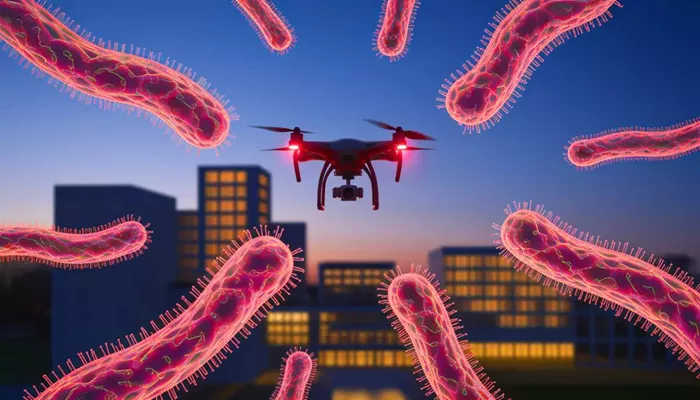In a development that blurs the boundaries between biology and technology, researchers at MIT have engineered bacteria capable of emitting light detectable from hundreds of feet away. This innovation enables living cells to transmit chemical messages across long distances—messages that can now be picked up by drones and satellites equipped with hyperspectral imaging systems.
Described by some as science fiction made real, this breakthrough holds significant promise for agriculture, environmental monitoring, and beyond. By transforming microbes into bioluminescent messengers, the MIT team has reimagined how living organisms can interact with machines—and how we read the language of nature from the sky.
A Leap in Long-Range Bacterial Communication
Until now, the use of engineered bacteria as environmental sensors has been limited to close-proximity settings, where highly specialized tools were needed to detect their fluorescent signals. The MIT researchers have shattered that barrier by designing bacteria that glow in both visible and infrared spectrums when exposed to specific chemicals. These light signals—known as hyperspectral optical signatures—can now be detected from distances of nearly 300 feet, radically extending the practical range of biosensing.
At the heart of the system is a set of “hyperspectral reporters”—genetically encoded light-emitting molecules that allow the bacteria to send out precise chemical signals. These reporters emit unique spectral fingerprints when triggered, which can be captured by hyperspectral cameras mounted on drones. According to Professor Christopher Voigt, a senior author of the study, this technology allows scientists to gather information from cells without physically observing them, unlocking a new method of biological communication.
From Lab to Field: Living Sensors at Work
Taking their invention beyond the lab, the MIT team tested the bacteria in various outdoor environments—from rooftops to arid desert plots. Encased in secure boxes, the bacteria were deployed on the ground while drones hovered overhead, scanning for the telltale glow of activated cells. The result: a high-speed, accurate remote sensing system capable of identifying chemical changes in less than 30 seconds per field.
One field test demonstrated the bacteria’s ability to detect arsenic, highlighting its potential in environmental safety. Researchers say this system could be easily adapted to sense other variables, such as nitrogen levels in soil—a critical marker for precision agriculture. Looking ahead, the possibility of integrating these bacteria directly into plant cells hints at even more powerful applications, allowing entire ecosystems to “speak” through spectral light.
The Science Behind the Glow
The magic of the technology lies in the genetic engineering of the bacteria’s light-emitting components. To identify the most effective molecules for hyperspectral signaling, the team analyzed over 20,000 natural compounds. Two stood out: biliverdin, a pigment from heme breakdown, and bacteriochlorophyll, used in photosynthesis by certain microbes. Both offered strong, distinct signals with minimal cellular burden.
These compounds were genetically tethered to sensor circuits within the bacteria. Once activated by specific chemicals—metals, radiation, or toxins—the microbes begin glowing in a pattern recognizable from the sky. “These reporters allow us to remotely detect what’s happening at a molecular level,” said Voigt, “greatly enhancing the capabilities of biosensors.”
Vast Potential, with Ethical Horizons
The scope of this technology’s potential is enormous. In agriculture, it could lead to more sustainable farming by optimizing fertilizer use and detecting nutrient deficiencies. In environmental science, it may offer a new method for identifying contamination or even locating landmines. Industrial systems and medical diagnostics could also benefit from embedded bacterial sensors tailored to specific chemical conditions.
Yet, this new frontier raises critical questions. With genetically modified organisms (GMOs) now functioning as remote data transmitters, regulatory frameworks and ethical standards must evolve to ensure safety and transparency. Co-author Yonatan Chemla emphasizes the need to address these concerns as the team pushes the technology forward.
A New Era of Biological Communication
As we enter this next phase of biosensing, glowing bacteria may soon become part of our everyday toolkit—monitoring ecosystems, guiding agriculture, or offering early warnings for environmental threats. The idea that a drone might one day “read” the health of a field by listening to the whispers of microbes no longer sounds far-fetched.
With imagination, rigorous science, and responsible innovation, this convergence of living systems and digital detection could reshape how we understand and interact with the world.

